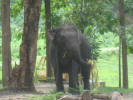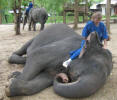ELEPHANT CONSERVATION CENTER, THAILAND |
Mahout School May 21 We went to the Thai Elephant Conservation Centre near Lampang to do a one day crash course to become an amateur mahout (elephant keeper). Our experience there was one we will always remember and we gained a new love and respect for the elephant. |
The elephants of Thailand are in distress. As the last centenary continues to fade into memories unfortunately so does the economic need for elephants. 100 years ago there was over 100,000 domestic elephants in Thailand. Used as the heavy lifting equipment of the day, these elephants hauled the precious teak wood to sell to The West. They worked on the farm hand in hand with farmers to put food on plates, they helped build bridges, houses, railway lines and in Military service along side human soldiers helping keep Thailand independent. Sadly the glory days of the elephant have gone. With the invention of better and better machines and the outlawing of logging in 1989 there has ceased to be an economic place for the thousands of elephants. Estimates vary and experts disagree but there are roughly 6000 elephant now in Thailand. The Elephant Conservation Center was established principally to conserve Thai Elephants now that these majestic animals are no longer needed and often uncared for. This excellent centre, which houses about 70 elephants, also promotes education about elephants. |
Now, time for the introductions. It was necessary that the elephants got to know our scent and voices if they were to cooperate in our mahout training experience. We talked gently to them, stroked their trunks but I think it was the bundles of sugar cane we offered that finally did the trick. Gord's elephant was a large male, known to be aggressive on occasion! There are two kind of male elephants and this one had the shorter tusks. My giant was a female, about 15 years old. |













































































